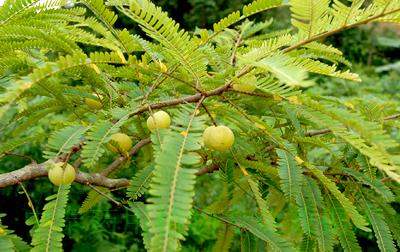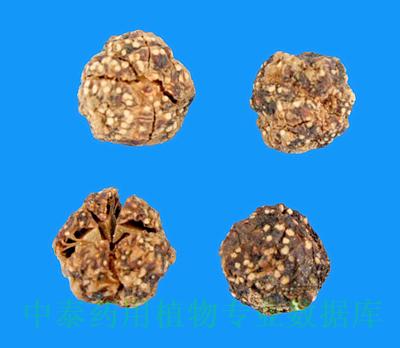| [English Name] | Emblic Leafflower Fruit | |
| [Chinese Name] | 余甘子 | |
| [Pinying Name] | Yuganzi | |
| [Latin Name] | Fructus Phyllanthi Emblicae | |
| [Genera] | Euphorbiaceae | |
| [Efficacy] | Antipyretic drug | |
| [Pictures] | Plant picture | Drug picture |

|

|
|
| [Alias] | Niuganzi, Houganzi, Yumuguo, Youganzi | |
| [Source] | This crude drug is the fruit of Phyllanthus emblica L. (family: Euphorbiaceae). |
|
| [Plant morphology] | ||
| [Distribution] | In China, this species is distributed in Fujian, Guangdong, Guangxi, Yunnan, Guizhou, Sichuan, Taiwan, Jiangxi, Hunan and Zhejiang; and the crude drug is produced in Sichuan, Guangdong, Guangxi, Guizhou and Yunnan. |
|
| [Gathering and processing] | The ripe fruit is picked in the autumn and dried in the shade. |
|
| [Characteristics] | ||
| [Ecology] | It grows in the open forest or the hillside exposed to the sunat the altitude between 300 to 1200 metres. | |
| [Chemical composition] | ||
| [Pharmacological activities] |
1 Anti-atheroscleroticplaque: Emblica officinalisinhibited the atherosclerotic plaque area as shown by 39%, depressed thecarotid artery atherosclerotic plaque degrees by 28%, reduced the plaqueelastic fibers contents by 33%, decreased the average layers of bubble cells by47% [1]. Emblic leafflower fruit prevents from the formation of experimentalatheromatous plaque in rabbit probably by regulating rabbit lipid metabolism,inproming anti-oxidation to reduce lipid peroxidation and protectingendothelial function to inhibit the expression of artery intima ET-1 gene [2].Phyllanthus emblica L., which is widely used in treatment ofatherosclerosis-related diseases and associated with ox-LDL by the solubletannin, Phy-13 (beta-1-O-galloyl-3,6-(R)-hexahydroxydiphenoyl-d-glucose), andits analogue Phy-16 (1,6-di-O-galloy l-beta-d-glucose)[3]. 2 Antimicrobial activity: Theextracts of Phyllanchus emblica L. had antimicrobial activity to the staphylococcusand typhoid bacillus [4]. The extracted oils have a high antimicrobial activityagainst the original contaminating bacteria such as Bacillus subtilis, Staphylococcusaureus, Escherichia coli, Salmonella, Saccgaromyces cerevisiae and Aspergillusoryzae [5]. 3 Antioxidant activity: The antioxidant activities of theoils were evaluated using 2, 2-diphenyl-1-picrylhydrazyl (DPPH) and linoleicacid peroxidation assays. The EC50 value of the emblica essential oils forscavenging DPPH radicals (11.2±1.6 μg/mL) was higher than that of BHA andα-tocopherol, while the oils exhibited higher inhibition activity thanα-tocopherol in the linoleic acid system. PhyllanthusEmblica L influence free radical reaction in rats and mice, enhance markedlythe activity of SOD and the level of serum Zn and Cu, and decrease the contentof serum LPO [7]. 4 Antihepatitis: The extraction of P emblica was able to reduce the content ofALT, malonyldialdehyde Alkaline Phosphatases and superoxide dismutase (MDA) and liver index. Moreover, it alsoincreased the activity of SOD and promoted the synthesisof liver glycogen. P. emblica have a good role inanti-liver fibrosis induced by porcine serum inrats [8-10]. 5 Antitumor: The gallicacid is cytotoxic to the variety of the cancer cells [11]. 6 The others:Phyllanthus emblica L contains rich vitamine C and has nourishing effect [4]. Phyllanthus emblica could inhibitthe formation of cotton ball granuloma, reduce the levels of serum TNF-α, IL-1βand NO [12]. The Phyllanthus emblica L fruit inhibited the RT of HIV-1 [13]. Phyllanthus emblica L. improved the activities of SOD,GSH-px, and reduced the contents of MDA, LPF significantly [14]. PELwater-extracts can prolong the duration of loaded-swimming and anti-hypoxiatime of mice, significantly decrease the contents of blood lactic acid, bloodurine nitrogen, and increase the contents of hepatic glycogen and bloodhemoglobin, significantly improved the activity of blood lactate dehydrogenase (LDH)[15]. Fructus Phyllanthi can raise the insulin and the glucagon, accelerate fatdissolving, raise FFA in blood and muscles, and economize Gln decrement [16]. |
|
| [Clinical trial] | 无 | |
| [Properties] | ||
| [Medical and other Uses] | ||
| [Dosage] | ||
| [Cautions] | ||
| [Traditional usage] |
1. Common cold, fever, cough, sore dry mouth, polydipsia, lack of Vita-C 2. Asthma 3. For Globefish toxication ( take the fresh Yuganzi), and for fishbone chock 4. Hypertension 5. Lung cancer 6. Vomiting due to food retention, abdominal pain, and diarrhea |
|
| [Toxicological studies] | ||
| [Pharmaceutical preparations] | ||
| [References] |
Pharmacology Actions: [1] Li-mei Liu, Zheng Gao, Baowen Li, Effect of emblica officinalis on formation of atherosclerotic plaque of carotid artery in experimental rabbits, Chinese Journal of Clinical Rehabilitation, 2003, 7 (5): 766. [2] Lv-ya Wang, Da-quan Wang, Yan-wen Qin et al., Effect of embic leafflower fruit on total antioxidation and levels of malondialdehyde as well as endothelin in plasma in rabbits with atherosclerosis, Chinese Journal of Clinical Rehabilitation, 2005, 9 (7): 253. [3] Ai-xiu Guo, Xing-guo Huang, Xiang-yun Tang, Mechanism of Anti- atherogenesis Effect of Soluble Tannins From Fructus PhyllanthiPractical Prevent ive Medicine, 2007, 14 (2): 352. [4] [5] Mo-ming Zhao, Xiao-li Liu, Chun Cui et al., Composition and Antimicrobial Activity of Essential Oil from Phyllanthus emblica L. by Supercritical CO2 Extraction, Journal of South China University of Technology ( Natural Science Edition), 2007, 35 (12): 116. [6] Xiao-li Liu, Mo-ming Zhao, Chun Cui et al., A Study of the Composition of Essential Oils from Emblica ( Phyllanthus emblica L1) Fruit by Supercritical Fluid Extraction and Their Antioxidant Activity, Journal of Southwest University ( Natural Science Edit ion), 2007, 29 (5): 122. [7] Minf-tang Liu, Wei-xin Guo, The Effect of Phullanthus Emblica L ona Serum SOD, LPO and Zn, Cu in rats and Mice, Journal of Fujian College of TCM, 1992, 26 (4): 297. [8] Ping Li, Jin-xian Xie, Qi-yun Lin, The impact of the national drug emblica D-galactosamine induced acute liver injury, Chinese Journal of Ethnomedicine and Ethnopharmacy, 2003, (3): 161. [9] Ping Li, Qi-yun Lin, Jin-xian Xie et al., The emblica hepatoprotective effect of experimental study, Chinese Archives of Traditional Chinese Medicine, 2003, 21 (9): 1589. [10] Ping Li, Jin-xian Xie, Qi-yun Lin et al., The emblica anti experimental study of chronic liver injury with hepatic fibrosis, Chinese Journal of Integrated Traditional and Western Medicine, 2002, 12 (6): 355. [11] Zhen-guo Zhong, Hong Liang, Yi-ning Zhong, Experimental Study on Antitumor Effect of Gallic Acid in Vitro, Lishizhen Medicine and Materia Medica research, 2009,(8):1954. [12] Rui-guo Wang, Liang-pu Zheng, Jiu-mao Lin et al., Experimental Study on Inhibitive Effect and Mechanism of Phyllanthus Emblica on the Formation of Cotton Ball Granuloma in Rats, Journal of Fujian College of TCM, 2007, 17 (4): 22. [13] Xiao-fang Sun, Wei Wang, Gui-you Du et al., Anti-human immunodeficiency virus drugs in Egyptian medicinal plants, Journal of Chinese Traditional Chinese Medicine, 2002, 27 (9): 649. [14] Bin-quan Cui, Yuan-zao Lin, Study on the Antiaging Effect of Phyllanthus emblica L., Lishizhen Medicine and Materia Medica research, 2007,18(9):2100. [15] Bin-quan Cui, Wei-qiao Huang, Yuan-zao Lin, Experimental Study of the Anti-Fatigue and Anti-Hypoxia Function of Phyllanthus emblica L. in Mice, Modern Chinese Medicine, 2008, 10 (6): 26. [16] Li Lin, The Influences of Fructus Phyllanthi and Intensive Endurance Training on Rats. Gln Stockpile and Fat Metabolism, Journal of |
|